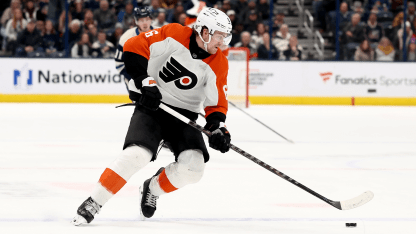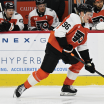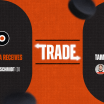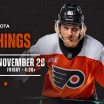Defenseman Travis Sanheim recently sat down with host Jason Myrtetus on Flyers Daily presented by Ticketmaster for a mid-season check-in. A stabilizing force on the blue-line, Sanheim has taken major strides in his game following a strong 2023-24 season and carried that momentum in 2024-25.
Never Satisfied: Sanheim Remains Focused on Stability and Team Growth
Defenseman Travis Sanheim recently sat down with host Jason Myrtetus on Flyers Daily presented by Ticketmaster for a mid-season check-in.

By
Philadelphia Flyers
philadelphiaflyers.com
Following offseason trade rumors just over a year and a half ago, Sanheim has turned in two of his most productive seasons in Orange and Black. Appearing in all 45 games for the Flyers this season, the 28-year-old has totaled 23 points (4g-17a) and logged heavy minutes with an average 24:38 TOI per game, which ranks 10th overall in the NHL. Sanheim utilized the trade rumors to prove his worth to the club.
“I've never been traded in my career, junior or at the pro level, so until you kind of go through that, I guess it's a different experience. You can react one way, and you can react another. You can sit around and pout about it, or you can do something about it. So, I just chose that I love this organization. I love being in Philly, it means a lot to play here so I just wanted to prove where my worth was at, prove the reason why I signed the contract that I did, and show this organization, fanbase, and my teammates that I want to be a part of this moving forward and trying to be a big part of it.”
Despite the obvious development in Sanheim’s game, the defenseman is still motivated to prove more to himself but to the greater hockey community at large. There’s been no greater proof that he’s been successful in his individual game than when the Manitoba-native was selected to represent Team Canada in the upcoming inaugural 4Nations Face-Off in February.
“Honestly, I wanted to take a huge step, not only to show that but to show where I'm at from a league standpoint and try to take my game to another level. Obviously, I've been able to do that, but in saying that, I still think there's tons of growth. I'm not satisfied. There's more to my game that I haven't necessarily touched, and I continue to work on it every day. I'm always trying to get better. I think that's the biggest thing I've learned…There's always young guys coming up trying to take your spot, and so you can't be satisfied. The minute you get satisfied is the minute you're out of this league. So, for me, it's just every day trying to get better, trying to work on all areas of my game. There isn't one specific area I think I'm trying to work on. I think I can continue to develop in multiple areas, and I think it's benefited me having that mindset to continue to grow and get better. That's how you improve your game.
It's a grind. I look back at the strides I've taken, and not just on the ice, but mentally, physically, treating my body the right way, how I'm working in practices, am I getting better or just out there for the skate, getting ready for the game. There are all different ways to look at our game every day, and it's crazy what you have to go through to get to that level of consistency and play needed at this level. I'm very happy with the strides I've taken.”
Personal development has been a positive story for Sanheim, the defenseman’s larger goal is for the Flyers to return to the playoffs and build a consistent contender in Philadelphia. To do that, the team must keep their focus on the task at hand and take a game-by-game approach.
“We’re not really listening to the outside noise. I think for us, it's known collectively as a group that we want to take those next steps. To do that, you've got to win hockey games, you've got to be competing against the top teams in the league, that's where you get better, that's where you figure out and learn a lot. You can learn how to handle yourself when it comes to those big teams and big games, what it takes to win at this level every night. It’s always a challenge trying to find that consistency. I think that's a big thing with young guys coming in; you can play one or two good games, can you do it for 20 games, can you do it for 30 games, and not having nights off. I think that's something we're continuing to work on and grow at. I think me and TK, being signed here for a while, we want to take it to the next level, build this team, get back to where we think we belong, and that’s playing meaningful hockey games, and playing in the postseason.”
Regularly one of the Flyers hardest workers, Sanheim has emerged into a role model for the younger players on the roster, who are looking to take the next step in their NHL careers.
“I just think there's so much to work on, and in practice, there's not enough time. Usually, you're working on team systems or quick drills to touch the ice and get ready for the game. For me, there are so many little things. I'm thinking in my head before what I'm going to work on. I like a lot of one-on-one stuff, just little things. It might even be flicking a puck out of my end zone…It might not look that difficult, but when you're under pressure, trying to punt that thing to the neutral zone, it's a lot harder than most people think. I'm playing my offside, so I've got to do it on my backhand. You've got to recognize the pressure, so I'll work on little things like that, even just stabbing the puck up the wall. I'll have a forechecker on me, and I've got to try to get that by him to the next layer of guys. There are just so many little areas that I think a lot of people don't necessarily see when watching the full picture of the game. There are so many little plays. When I'm watching hockey, I'm looking at how the defenseman makes that little outlet pass - you guys probably aren't even worried about; you're worried about how the rush is going up the ice, and I'm worried about how did it get there…If you can work on it, I think you have to get to that level of consistency; you have to get the reps. It's not something that just happens. You have to see it, be able to do it. I'll be out there making tons of mistakes, and that's what I'm looking for.
It might be something simple. So, it's just continuing to work on that, finding that consistency, and then it's going to show up in the game. I've had a lot of success that way, so I'm going to continue to keep doing that. I've got guys coming up to me now asking about one-timers because I spent a whole offseason trying to figure out my one-timer. I couldn't take one for the longest time coming out of junior and even throughout my early career, early pro career, and I was able to figure it out. I watched a lot of tape on other guys, just little techniques, and now we've got TK on it, Frosty's coming up to me asking about it. It's such a process; it doesn't just happen. You have to slow it down, break it down into little pieces. Might start with your stick six inches off the ice, that's how you start taking them, getting your contact down, and eventually, you're going to work your way up to getting cross-ice passes and being able to hit the puck. So, just little things like that, that's the way I'm viewing the game, and it's a different side of it, but I get a lot of enjoyment out of it.”


















